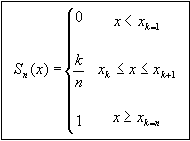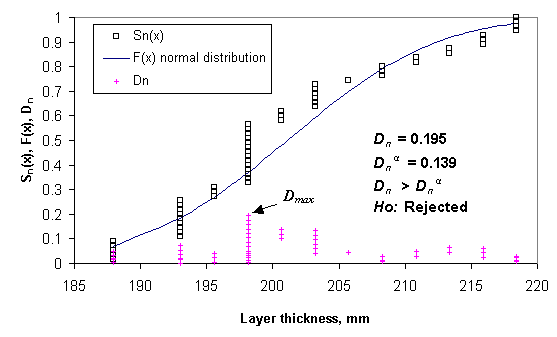U.S. Department of Transportation
Federal Highway Administration
1200 New Jersey Avenue, SE
Washington, DC 20590
202-366-4000
Federal Highway Administration Research and Technology
Coordinating, Developing, and Delivering Highway Transportation Innovations
 |
| This report is an archived publication and may contain dated technical, contact, and link information |
|
Publication Number: FHWA-RD-03-041 |
The Kolmogorov-Smirnov test procedure involves the comparison between the experimental cumulative frequency and an assumed theoretical distribution function. If the discrepancy is large compared to what is normally expected from a given sample size, the theoretical model is rejected.
The Kolmogorov-Smirnov test procedure involves the following steps:

Figure 94: Equation. Cumulative frequencies definition.
Where xk is a layer thickness value from sample of n layer thickness measurements sorted in the ascending order by thickness value. The k - index indicates the order of layer thickness observation in the sorted layer thickness array.
Figure 95: Equation. D-max statistic definition.
8. Select level of significance α = 1 percent
9. Compute the critical value
![]() based on selected value of α. Based on value of n,
based on selected value of α. Based on value of n,
![]() is found as following
is found as following

Figure 96: Equation. Critical value ![]() definition.
definition.
10. The Kolmogorov-Smirnov test determines whether, for specified level of significance α, the proposed distribution is an acceptable representation of the field data.

Figure 97: Equation. Kolmogorov-Smirnov test evaluation criteria.
The following figure 98 demonstrates the results of the Kolmogorov-Smirnov test for a layer that did not pass the test of normality.

Figure 98: Chart. Example of Kolmogorov-Smirnov normal distribution goodness-of-fit test (DGAB layer SPS-1 LTPP section 01_0101).
The layer thickness measurements taken along the SPS LTPP sections for the structural layers were tested to determine how well the distribution of layer thickness measurements taken along the LTPP section follow selected theoretical distribution. The following table 69 provides the description of the layer and material types used in the SPS experiments. The table also provides information about layer thickness measurement sample sizes available in the LTPP database.
Layer-Material Type |
Total number of samples |
Number of samples with the following number of observations |
||||||||||||
|---|---|---|---|---|---|---|---|---|---|---|---|---|---|---|
1 |
5 |
10 |
15 |
20 |
25 |
30 |
35 |
40 |
45 |
50 |
55 |
60 or more |
||
AC_SURFACE_COURSE |
133 |
4 |
0 |
0 |
1 |
1 |
7 |
0 |
0 |
0 |
0 |
3 |
117 |
0 |
BINDER_COURSE |
50 |
1 |
3 |
0 |
0 |
1 |
3 |
0 |
0 |
0 |
0 |
4 |
38 |
0 |
DENSE_GRADE_AGG_BASE |
220 |
1 |
0 |
2 |
5 |
0 |
3 |
15 |
0 |
1 |
8 |
1 |
174 |
10 |
DENSE_GRD_ASPH_TREAT_BASE |
97 |
0 |
0 |
1 |
0 |
0 |
0 |
0 |
0 |
0 |
2 |
2 |
92 |
0 |
LEAN_CONCRETE |
48 |
0 |
0 |
0 |
0 |
0 |
0 |
8 |
0 |
0 |
0 |
0 |
35 |
5 |
PCC_SURFACE |
178 |
1 |
0 |
1 |
0 |
0 |
2 |
40 |
1 |
0 |
2 |
3 |
112 |
16 |
PERM_ASPH_TREAT_BASE |
130 |
1 |
0 |
2 |
0 |
0 |
1 |
9 |
0 |
0 |
1 |
1 |
111 |
4 |
AC_SURFACE_AND_BINDER |
191 |
0 |
0 |
2 |
0 |
0 |
0 |
0 |
1 |
0 |
4 |
4 |
177 |
3 |
One data sample represents a group of measurements taken along the LTPP section for a specific layer and material type. There are 1,047 layers with thickness measurements along the LTPP section available in the LTPP database for the surface and base courses. The number of thickness measurements per layer and material type taken along the LTPP section ranges from 1 to 60. About 85 percent of all layers have at least 55 observations.
A total of 1034 pavement layers were tested to determine how well variability in layer thickness data along the LTPP section could be described using normal distribution. Kolmogorov-Smirnov goodness-of-fit test evaluated for level of significance alpha equal to 1 percent are summarized in table 70.
The results did not show as strong an indication of layer thickness distribution normality as the results of combined skewness and kurtosis test. This could be explained by lower power of Kolmogorov-Smirnov goodness-of-fit test compared to the combined skewness and kurtosis test. Low power indicates high probability of failing to reject the false null hypothesis.
Experiment |
Number of layers |
Not rejected (Normal) |
Rejected (Not normal) |
AC_SURFACE_COURSE |
|||
SPS-5 |
93 |
34 (36.6 %) |
59 (63.4 %) |
SPS-6 |
36 |
12 (33.3 %) |
24 (66.7 %) |
SURFACE_AND_BINDER |
|||
SPS-1 |
167 |
61 (36.5 %) |
106 (63.5 %) |
SPS-8 |
22 |
14 (63.6 %) |
8 (36.4 %) |
PERM_ASPH_TREAT_BASE |
|||
SPS-1 |
83 |
46 (55.4 %) |
37 (44.6 %) |
SPS-2 |
46 |
28 (60.9 %) |
18 (39.1 %) |
PCC_SURFACE |
|||
SPS-2 |
139 |
70 (50.4 %) |
69 (49.6 %) |
SPS-7 |
24 |
21 (87.5 %) |
3 (12.5 %) |
SPS-8 |
14 |
9 (64.3 %) |
5 (35.7 %) |
LEAN_CONCRETE |
|||
SPS-2 |
48 |
26 (54.2 %) |
22 (45.8 %) |
DENSE_GRD_ASPH_TREAT_BASE |
|||
SPS-1 |
97 |
45 (46.4 %) |
52 (53.6 %) |
DENSE_GRADE_AGG_BASE |
|||
SPS-1 |
97 |
63 (64.9 %) |
34 (35.1 %) |
SPS-2 |
84 |
53 (63.1 %) |
31 (36.9 %) |
SPS-8 |
38 |
30 (78.9 %) |
8 (21.1 %) |
BINDER_COURSE |
|||
SPS-5 |
33 |
11 (33.3 %) |
22 (66.7 %) |
SPS-6 |
13 |
7 (53.8 %) |
6 (46.2 %) |